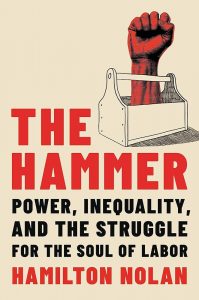The Hammer: Power, Inequality, and the Struggle for the Soul of Labor
 The Hammer: Power, Inequality, and the Struggle for the Soul of Labor, by Hamilton Nolan (New York: Hachette Books, 2024)
The Hammer: Power, Inequality, and the Struggle for the Soul of Labor, by Hamilton Nolan (New York: Hachette Books, 2024)
Nearly a century ago pioneer labor economist Selig Perlman observed that the American Federation of Labor pursued a limited goal of “communism of opportunity” rather than “communism of condition” for its members. With equal opportunity workers would ultimately prosper. What the AFL did not anticipate is what author Hamilton Nolan calls the “gargantuan levels of inequality” that exist today.
In The Hammer, Nolan expresses outrage over this deep division of wealth. He writes that in his lifetime “the rich have gotten richer, and the rest of us haven’t.” As proof he cites a 75 percent increase in worker productivity unmatched by commensurate compensation. Additionally, from 1979 to 2023 “the real incomes of the top 10 percent of Americans grew by more than 150 percent,” and “the top 1 percent grew by more than 250 percent. Most revealing, and the incomes of the “top .01 percent grew by nearly 500 percent.” The numbers are overwhelming and appalling. Not expecting government assistance to remedy this inequity, Nolan argues that the “only mechanism” to deal with it is organized labor.
An experienced labor journalist, Nolan cites several individuals who have fought to achieve such economic justice. Sara Nelson, international president of the 50,000-member Association of Flight Attendants, is his foremost example. Catapulted to national prominence through a highly energetic, but unsuccessful, campaign to gain election in 2022 to the presidency of the AFL-CIO, she ushered in a wave of organizational activity that aimed at reversing the seven-decade decline in union membership. An activist left-leaning Democrat as well as union leader, she sought to reform what Nolan describes as a “mediocre in-house lobbying firm and traffic cop for America’s unions.”
As low as the 7 percent national union membership rate was in 2022, it towered above the figure for South Carolina, which was at the nation’s bottom with only 1.7 percent. Recalling a 1934 massacre of six striking textile workers in a company town, Honea Path, South Carolina, Nolan recounts the sorry story of labor organizing in that state and throughout the South but notes a rare success in 2022. There were three union organizing election victories at Starbucks locations. Despite these gains, major victory remains distant. According to unionist Leonard Riley, even with a strong, Black-led longshoremen’s organization at the Port of Charleston, South Carolinians are “addicted to free labor. Or cheap labor.”
Written with fervor and grace, Nolan’s book is personal and compelling. It chronicles a host of workers and their struggles. From childcare workers in California, to the Culinary Union of Las Vegas, and Nabisco bakery workers in Portland, Oregon, the story is essentially the same, one of hardship and resilience in the face of management resistance to change. If there is a standard bearer for change, it is Sara Nelson. Alas, she needs assistance, which has not been demonstratively forthcoming from the AFL-CIO. A notable exception is Unite Here, the 300,000 hospitality workers union, which has fought many bitter battles, both internally and externally. In Congress Vermont’s Senator Bernie Sanders has stood out as a friend of unions.
Yes, the road ahead is strewn with obstacles. Workers remain divided by aggressive union-busting tactics, including attempts to undermine the Wagner Act of 1935, such as by packing the National Labor Relations Board with members friendly to management, enforcing the anti-labor provisions of the Taft-Hartley Act of 1947, and injecting race, religion and ethnicity into labor disputes.
Nevertheless, Nolan is nevertheless optimistic that the road can be traveled. He calls for workers to do just that, by using their labor as their “weapon,” their “hammer.” They must abandon “the handshake” in order ” to shape “a better America” that already exists. His is a call to action, to use what is already at their disposal, “to act.”
Reviewed by Robert D. Parmet, York College of the City University of New York
